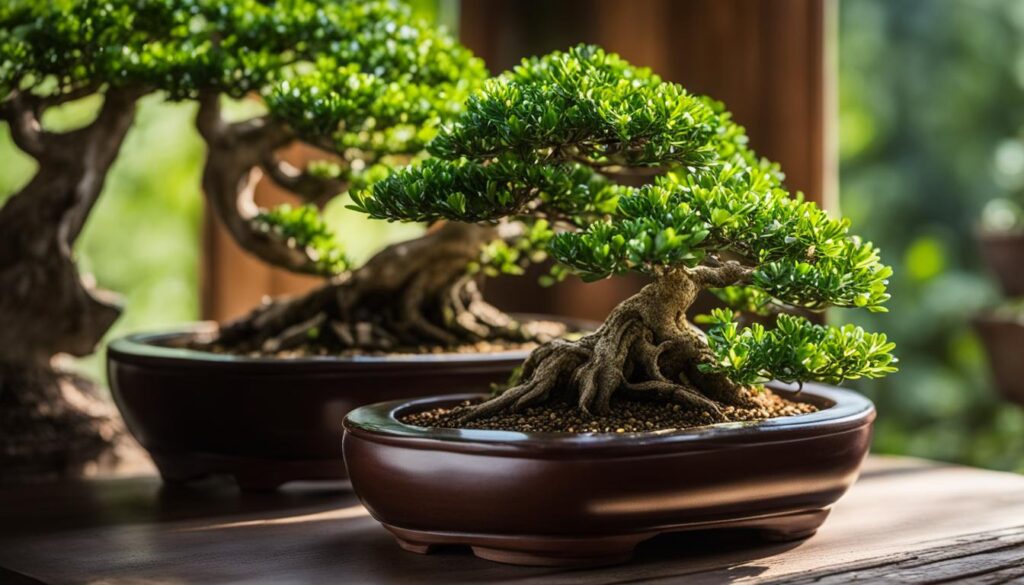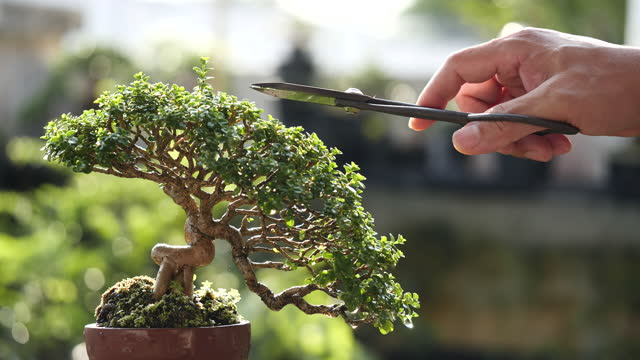Welcome to our comprehensive guide on growing and caring for Boxwood Bonsai (Buxus harlandii). If you’re looking to cultivate a visually stunning bonsai tree with unique features and distinctive characteristics, you’ve come to the right place. In this guide, we’ll provide you with all the essential information you need to know to ensure the long-term health and vigor of your Boxwood Bonsai.
Boxwood Bonsai, also known as Buxus harlandii, is a captivating and popular choice among bonsai enthusiasts. Its intricate foliage structure, compact size, fast growth, and ability to be styled in various ways make it a highly sought-after bonsai tree.
Throughout this guide, you’ll learn how to select the right Boxwood Bonsai for your needs, master the art of pruning and styling, understand the ideal lighting and soil conditions for healthy growth, and discover the diverse varieties available in the bonsai world. We’ll also provide tips on where to find reputable sellers and nurseries if you’re interested in purchasing a Boxwood Bonsai.
Discover the World of Boxwood Bonsai: An Introduction

Welcome to the captivating world of Boxwood Bonsai. In this section, we will embark on a journey to explore the origins, history, and cultural significance of this exquisite art form. Boxwood Bonsai, also known as Buxus harlandii, has gained immense popularity among bonsai enthusiasts for its unique features and timeless beauty.
Boxwood Bonsai trees, with their lush green foliage and intriguing twisted trunks, bring a touch of nature’s elegance into any garden or indoor space. These miniature trees have been cherished and cultivated for centuries, originating from East Asia’s ancient tradition of bonsai cultivation.
Throughout history, Boxwood Bonsai has been revered for its symbolic meaning and aesthetic appeal. It represents harmony, longevity, and the balance between nature and human intervention. As bonsai enthusiasts, we create and cultivate these living works of art, fostering a deep connection with nature and the tranquility it brings.
Boxwood Bonsai trees offer a remarkable range of possibilities for expression and creativity. From its distinctive foliage to its beautifully shaped trunk and branches, every detail of a Boxwood Bonsai tells a story and evokes a sense of wonder. As you delve into the art of Boxwood Bonsai, you will discover the joy of nurturing and shaping these miniature trees, transforming them into living masterpieces.
By the end of this section, you will have gained a better understanding of the rich cultural heritage and aesthetic allure that Boxwood Bonsai brings. Let us dive deeper into the world of Boxwood Bonsai, filled with beauty, creativity, and a sense of Zen.
Unveiling the Unique Features of Boxwood Bonsai
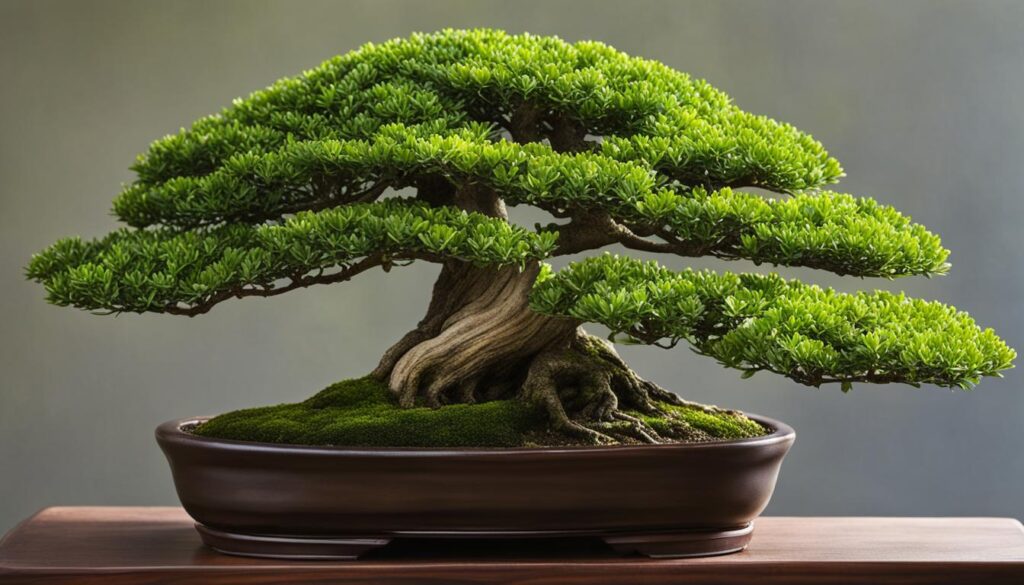
Boxwood Bonsai, or Buxus harlandii, possesses a set of unique features and distinctive characteristics that set it apart from other bonsai varieties. Understanding these characteristics is crucial for providing the appropriate care and maintenance for your Boxwood Bonsai. In this section, we will delve into the specific traits of Buxus harlandii and explore why Boxwood Bonsai stands out in the bonsai world.
Understanding Buxus harlandii’s Distinctive Characteristics
Boxwood Bonsai, with its evergreen foliage and fine-textured leaves, offers a timeless beauty that enhances any setting. The small and compact nature of its growth makes it an ideal choice for bonsai enthusiasts who appreciate its delicate appearance. Additionally, Boxwood Bonsai has the remarkable ability to withstand extensive pruning and shaping, allowing you to create intricate and captivating designs.
One unique feature of Boxwood Bonsai is its dense growth habit, which contributes to its bushy and full appearance. The intricately patterned bark and gnarled trunks add character and interest to this miniature tree, making it a focal point in any bonsai collection. Furthermore, Buxus harlandii is known for its slow growth rate, allowing you to enjoy the art of bonsai cultivation without the need for frequent trimming.
Why Boxwood Bonsai Stands Out Among Other Bonsai Varieties
Boxwood Bonsai stands out among other bonsai varieties for its versatility and adaptability. Whether you prefer a formal upright style, cascade style, or informal group planting, Boxwood Bonsai can be shaped and styled to suit various design preferences. Its small leaves and tight foliage create a sense of proportion and balance, resulting in a visually pleasing bonsai tree.
Another reason why Boxwood Bonsai stands out is its resilience and ability to thrive in different conditions. It can tolerate both sun and shade, although it prefers partial shade in hot climates. Additionally, Boxwood Bonsai is known for its resistance to pests and diseases, making it a low-maintenance choice for bonsai enthusiasts.
| Distinctive Characteristics of Boxwood Bonsai | Reasons for Standing Out |
|---|---|
| Evergreen foliage and fine-textured leaves | Timeless beauty and delicate appearance |
| Dense growth habit and intricate bark | Bushy and full appearance, adds character |
| Slow growth rate | Low maintenance, less frequent trimming |
| Versatility in shaping and styling | Suitable for various bonsai design preferences |
| Resilience and adaptability | Thrives in different conditions, resistant to pests and diseases |
By understanding the unique features and characteristics of Boxwood Bonsai, you can create a captivating bonsai tree that truly stands out. The next section will guide you in choosing the perfect Boxwood Bonsai for your collection, ensuring a harmonious blend of aesthetics and care requirements.
Choosing Your Boxwood Bonsai: Selection Tips and Advice
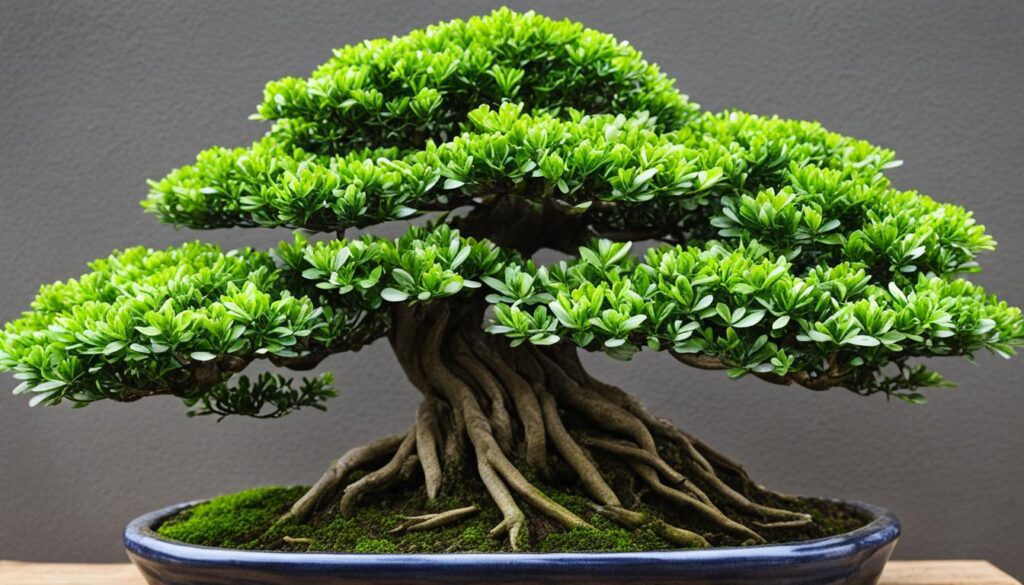
Selecting the right Boxwood Bonsai is crucial for ensuring its long-term success and your satisfaction as an owner. When choosing a Boxwood Bonsai, there are several important factors to consider. These include the age of the bonsai, the thickness of its trunk, the health of its root system, and its overall condition. By taking these factors into account, you can find a Boxwood Bonsai that meets your specific preferences and requirements.
Age: The age of a Boxwood Bonsai plays a significant role in its appearance and potential for future growth. Younger bonsai trees offer more flexibility in terms of training and styling, allowing you to shape them according to your desired vision. On the other hand, older bonsai trees tend to have more refined and developed characteristics, offering a sense of maturity and elegance.
Trunk Thickness: The thickness of the trunk is another critical aspect to consider when selecting a Boxwood Bonsai. A thick trunk signifies the age and maturity of the bonsai, while a thinner trunk indicates a younger tree. The thickness of the trunk can contribute to the overall aesthetic appeal and balance of the bonsai, so choose according to your preferred style.
Root System: The health and vitality of the root system are essential for the long-term viability of a Boxwood Bonsai. Inspect the roots carefully to ensure they are well-developed, free from rot or damage, and firmly anchored within the soil. A healthy root system will provide the necessary support and nutrients for the bonsai tree to thrive.
Overall Condition: It is essential to thoroughly assess the overall condition of the Boxwood Bonsai before making a purchase. Look for signs of good health, such as vibrant foliage, sturdy branches, and no evidence of pests or diseases. Avoid bonsai trees that show signs of stress, such as yellowing leaves, wilting, or weak growth.
Where to Find Reputable Sellers: When looking for a Boxwood Bonsai for sale, it is crucial to find reputable sellers or nurseries that offer high-quality bonsai trees. Seek out trusted bonsai dealers who have a strong reputation for providing healthy and well-cared-for bonsai. Online marketplaces and dedicated bonsai nurseries can be excellent sources for finding a wide variety of Boxwood Bonsai options.
By considering these selection tips and advice, you can choose a Boxwood Bonsai that meets your expectations in terms of aesthetics, age, and health. Remember that each Boxwood Bonsai is unique, so take the time to find the one that resonates with your personal style and brings you joy as you embark on this rewarding bonsai journey.
Boxwood Bonsai Care Essentials

Proper care is essential for the health and vitality of your Boxwood Bonsai. In this section, we will cover the key elements of caring for your bonsai, including the right lighting environments, irrigation techniques to ensure proper hydration, and the nutritional needs of your Boxwood Bonsai. We will also discuss the importance of pruning for maintaining the desired shape and size of your bonsai tree.
The Right Lighting Environments for Healthy Growth
Boxwood Bonsai thrives in bright, indirect sunlight. Place your bonsai in a location where it can receive at least 4-6 hours of sunlight each day. However, avoid exposing your Boxwood Bonsai to intense, direct sunlight, as it can cause leaf burn and affect the overall health of the tree. If you’re growing your bonsai indoors, consider placing it near a south-facing window or using artificial grow lights to provide adequate light.
Irrigation Techniques to Keep Your Bonsai Thriving
Proper watering is crucial for the well-being of your Boxwood Bonsai. The key is to maintain a consistent level of moisture in the soil without overwatering. Check the moisture level by inserting your finger about an inch into the soil. If it feels dry, it’s time to water. Use a watering can with a fine rose attachment to distribute water evenly throughout the soil. Be mindful not to let the bonsai sit in stagnant water, as it can lead to root rot. Adjust your watering frequency based on the season, as bonsai may require more water during hotter months.
Nutrition Needs: Fertilizing Your Boxwood Bonsai
Regular fertilization is essential to provide the necessary nutrients for the healthy growth of your Boxwood Bonsai. Use a balanced, slow-release bonsai fertilizer that is specifically formulated for acid-loving plants. Apply the fertilizer according to the manufacturer’s instructions, typically during the growing season from spring to early fall. Avoid overfertilizing, as it can lead to nutrient burn and damage the roots. Monitor the health and growth of your bonsai, and adjust your fertilization schedule as needed.
Pruning plays a vital role in shaping and maintaining the desired appearance of your Boxwood Bonsai. It helps control the size, remove unwanted branches, and encourages the development of a dense foliage canopy. To prune your bonsai, use sharp and clean bonsai pruning scissors to make precise cuts. Start by removing any dead or diseased branches. Then, selectively prune branches to maintain the desired shape and overall balance of the tree. Regular pruning will enhance the aesthetic appeal and health of your Boxwood Bonsai.
Planting Your Bonsai: The Importance of Boxwood Bonsai Soil
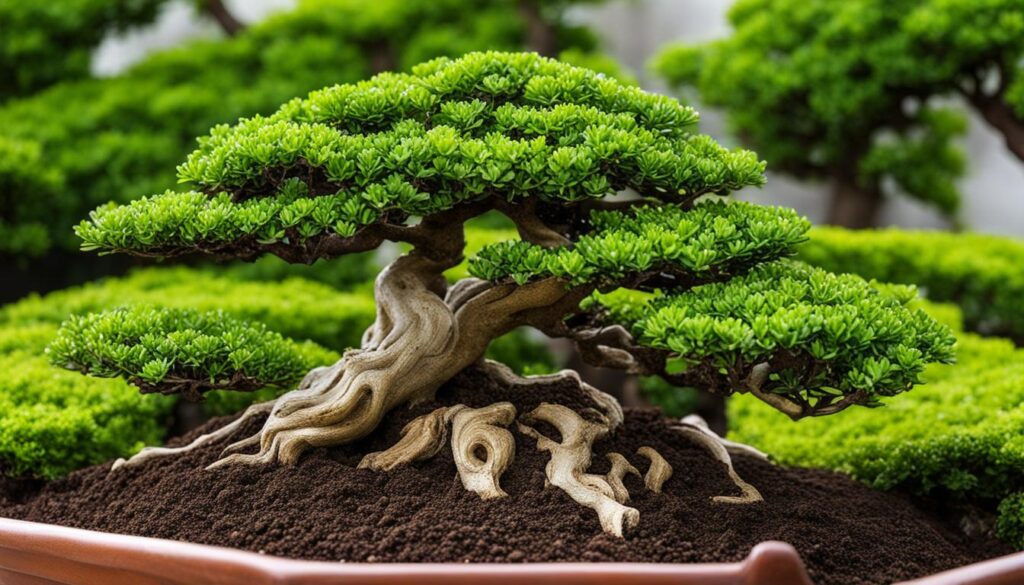
The choice of soil is crucial for the healthy growth and development of your Boxwood Bonsai. Boxwood bonsai trees have specific soil requirements that must be met to ensure their optimal health and vitality. In this section, we will explore the importance of proper soil composition, drainage, and aeration for your bonsai tree.
When it comes to boxwood bonsai soil, there are a few key factors to consider:
- Soil Composition: Boxwood bonsai trees thrive in well-draining soil that retains just enough moisture. A suitable soil mixture for boxwood bonsai should be a blend of organic matter, such as compost or peat moss, and inorganic materials like perlite or grit. This combination promotes root development and irrigation efficiency.
- Drainage: Good drainage is essential to prevent waterlogging, which can lead to root rot and other diseases. Ensure that your bonsai pot has drainage holes to allow excess water to escape. Additionally, incorporating coarse sand or gravel into the soil mixture improves drainage.
- Aeration: Boxwood bonsai requires adequate oxygen around their roots. To enhance aeration, vermiculite or pumice can be added to the soil mix. These materials improve air circulation within the soil and prevent compaction.
Now that you understand the importance of soil composition, drainage, and aeration, let’s take a closer look at the step-by-step process of planting your Boxwood Bonsai:
- Select a suitable bonsai pot that provides enough space for your boxwood tree’s root system to grow. Ensure that the pot has drainage holes.
- Prepare the soil mixture by combining the organic and inorganic materials in the appropriate proportions. Thoroughly mix the components to achieve a balanced blend.
- Gently remove the boxwood bonsai from its nursery container, taking care not to damage the roots.
- Place a layer of the prepared soil mixture at the bottom of the bonsai pot.
- Position the bonsai tree in the center of the pot, ensuring that it is upright and balanced.
- Gradually fill the remaining space in the pot with the soil mixture, gently pressing it around the roots to provide stability and remove any air pockets.
- Water the bonsai thoroughly to settle the soil and hydrate the roots. Allow excess water to drain out through the drainage holes.
By following these planting instructions and using the appropriate soil mixture, you are setting the foundation for your Boxwood Bonsai’s healthy growth and development. Remember to monitor the moisture levels and adjust your watering routine accordingly. With proper soil and planting techniques, your Boxwood Bonsai will thrive and bring you years of beauty and enjoyment.
Mastering the Art of Boxwood Bonsai Pruning
Pruning is a crucial skill to master when cultivating boxwood bonsai. By understanding the proper techniques, tools, and timing involved, you can ensure the health and aesthetic appeal of your bonsai tree. Pruning not only helps maintain the desired shape and size of your bonsai but also promotes new growth, strengthens the branch structure, and enhances overall vitality.
The purpose of pruning is to remove unwanted or excessive branches, leaves, and shoots. It also encourages ramification, which refers to the development of a dense network of branches and foliage. Through pruning, you can create a balanced and visually pleasing bonsai tree that reflects your artistic vision.
When it comes to boxwood bonsai pruning, there are a few key guidelines to follow:
- Timing: The optimal time to prune boxwood bonsai is during the late winter or early spring, just before the new growth emerges. Pruning during this period allows the bonsai to recover and heal before the growing season begins. However, light pruning and maintenance trimming can be done throughout the year as needed.
- Techniques: Two primary pruning techniques are commonly used for boxwood bonsai. The first is maintenance pruning, which involves the removal of excess growth to maintain the desired shape. The second is structural pruning, which focuses on enhancing the overall structure and branch arrangement of the bonsai tree. Different tools, such as pruning shears and concave cutters, may be used depending on the size and thickness of the branches.
- Branch selection: When pruning boxwood bonsai, it’s important to select which branches to keep and which to remove. Ideally, you should choose branches that contribute to the overall design and flow of the bonsai tree. Branches that grow straight outward or cross each other can be removed to create a more harmonious structure.
Remember to always sterilize your pruning tools before and after each use to prevent the spread of diseases or pests. Additionally, observe the growth patterns and reactions of your boxwood bonsai after pruning to assess its health and adjust future pruning practices accordingly.
Styling Your Boxwood Bonsai: Techniques and Inspirations
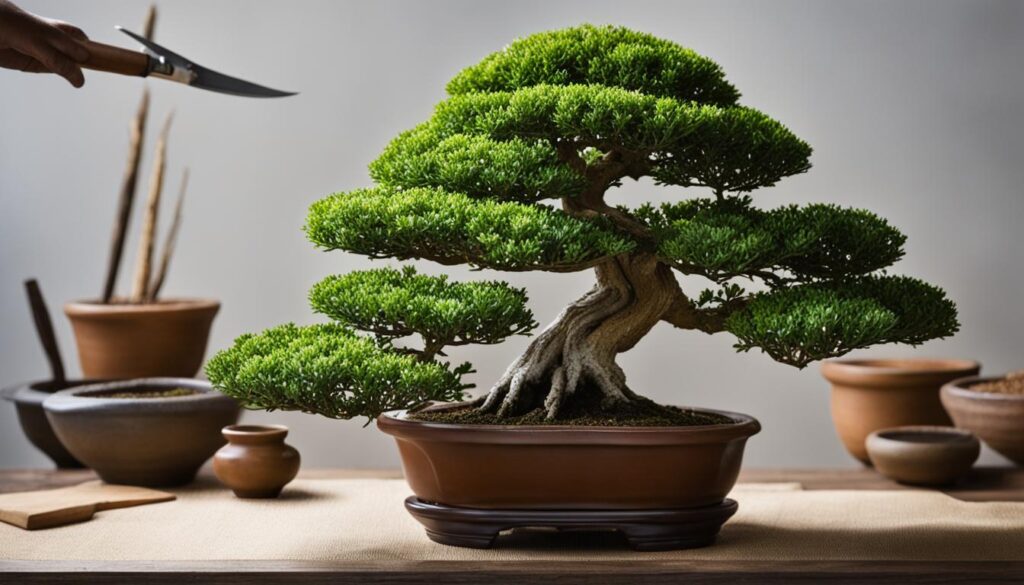
Styling your Boxwood Bonsai is a delightful opportunity to unleash your artistic vision and infuse your unique creativity into your bonsai tree. By carefully shaping and manipulating its branches, you can create a visually striking masterpiece that reflects your personal style. In this section, we will explore various techniques for styling your Boxwood Bonsai, as well as provide inspirational ideas for different bonsai styles.
One of the key techniques for styling boxwood bonsai is wiring. By gently wrapping aluminum or copper wire around the branches, you can guide their growth and create elegant curves or dramatic twists. It’s important to choose the right wire thickness and apply it with precision to avoid damaging the delicate branches.
Branch manipulation is another technique that can help you achieve the desired shape and structure for your Boxwood Bonsai. By carefully pruning and training the branches, you can create a sense of balance and harmony in your bonsai design. Remember to use sharp and clean pruning tools to ensure a clean cut and minimize the risk of infection.
When it comes to styling your Boxwood Bonsai, the possibilities are endless. You can opt for a classic and formal design, characterized by balanced symmetry and meticulous pruning. This style exudes elegance and refinement, making it a popular choice among bonsai enthusiasts.
If you prefer a more natural and informal look, you can go for an informal upright style or a slanting style. These styles mimic the appearance of trees growing in nature, with branches that bend and sway in a graceful manner. These designs exude a sense of freedom and evoke a serene and tranquil atmosphere in any space.
To give you further inspiration, here’s an image showcasing the captivating art of boxwood bonsai styling:
Through thoughtful styling, you can bring out the inherent beauty of your Boxwood Bonsai and create a bonsai tree that truly reflects your artistic expression. Let your imagination soar as you explore different techniques and embrace the art of boxwood bonsai styling.
Exploring the Diversity of Boxwood Bonsai Varieties
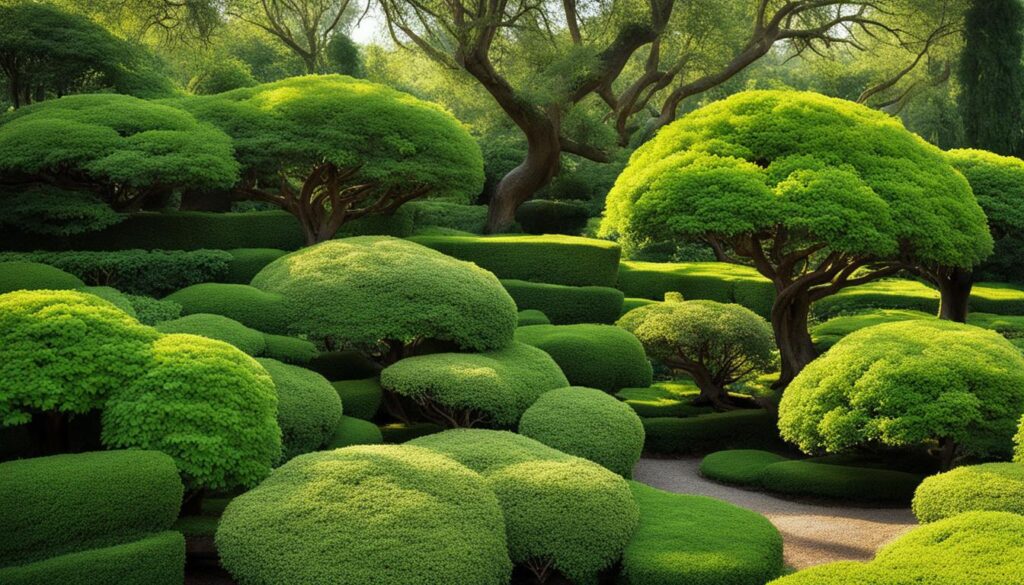
Boxwood Bonsai offers a diverse range of varieties, each with its unique characteristics and growth patterns. From compact shrub-like varieties to more upright and majestic ones, the world of Boxwood Bonsai presents a wealth of options for bonsai enthusiasts to explore. Let’s take a closer look at some popular Boxwood Bonsai varieties and discover their distinct features.
1. Green Gem: This variety is known for its dense and compact growth habit, making it an excellent choice for creating formal bonsai designs. Its small leaves and branches are highly responsive to pruning and shaping, allowing you to achieve precise and intricate styles.
2. Green Velvet: With its lush dark green foliage, the Green Velvet variety adds a touch of elegance to any bonsai collection. Its leaves are slightly larger than other varieties, providing a visually appealing contrast when styled in a more informal design.
3. Fastigiata: Also known as English Boxwood, this variety features an upright and columnar growth habit. Its narrow leaves and compact form make it ideal for creating bonsai with a distinctive vertical aesthetic. The Fastigiata variety is highly adaptable and tolerant of various pruning and styling techniques.
4. Graham Blandy: This variety is prized for its striking columnar shape and vibrant green foliage. Its slender branches and dense growth make it a popular choice for creating bonsai with a more contemporary and architectural style.
5. Rotundifolia: The Rotundifolia variety is characterized by its rounded leaves and dense foliage. It is well-suited for informal and naturalistic bonsai designs, where its lush greenery can be showcased in a more relaxed and organic form.
When caring for Boxwood Bonsai, it’s important to consider the specific needs of each variety. While the general care guidelines remain the same, factors such as growth rates, pruning requirements, and light preferences may vary between different Boxwood Bonsai varieties. By understanding the distinct features of each variety and tailoring your care approach accordingly, you can ensure the health and vitality of your Boxwood Bonsai collection.
Finding Boxwood Bonsai for Sale: Purchasing and Transport Tips
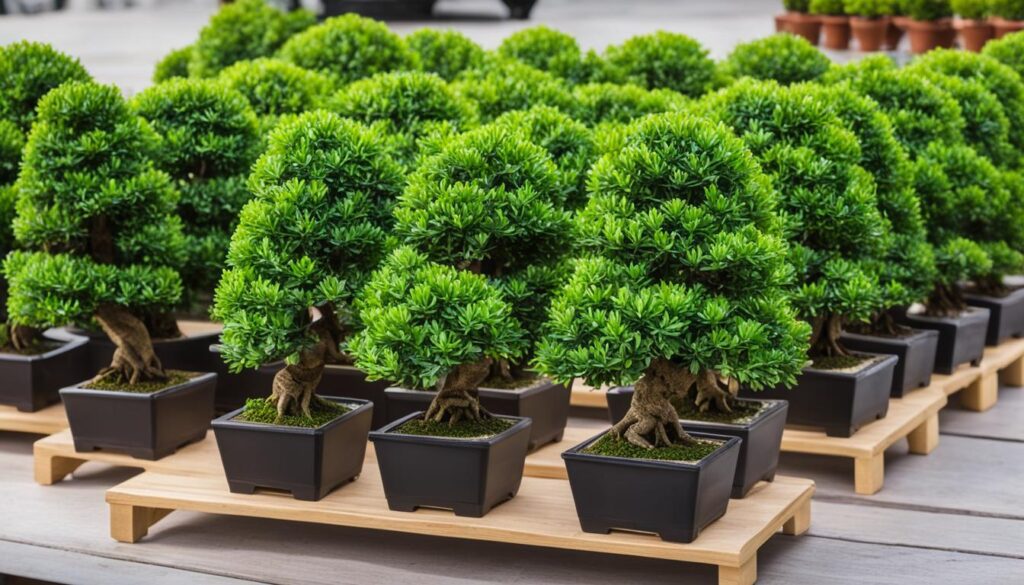
If you are looking to add a Boxwood Bonsai to your collection, it is essential to know where and how to find reputable sellers and nurseries. Purchasing a boxwood bonsai requires careful consideration and evaluation to ensure you are getting a healthy and high-quality tree. Here are some tips and advice to help you make the right choices:
- Research reputable sellers: Start your search by looking for established and reputable sellers or nurseries specializing in bonsai. Read reviews and customer feedback to gauge their quality and customer service. Look for sellers who have a wide selection of boxwood bonsai for sale.
- Attend bonsai exhibitions and shows: Bonsai exhibitions and shows often attract reputable sellers and bonsai enthusiasts. Visiting these events can give you the opportunity to see a variety of boxwood bonsai trees and meet knowledgeable sellers who can provide guidance on selecting the right tree for you.
- Consider online marketplaces: Online marketplaces can be a convenient way to find boxwood bonsai for sale. However, exercise caution and research the seller’s reputation and shipping practices before making a purchase.
- Evaluate the tree’s health: When buying a boxwood bonsai, carefully inspect the tree for any signs of pest infestation, disease, or poor health. Look for vibrant green leaves, healthy bark, and an overall well-maintained appearance.
- Ask questions: Don’t hesitate to ask the seller questions about the bonsai’s history, care requirements, and any specific concerns you may have. A knowledgeable seller will be happy to provide you with detailed information.
- Transporting your bonsai: Once you have purchased your boxwood bonsai, it is crucial to transport it safely to your home. Here are some tips to ensure a smooth transportation process:
Transportation Tips:
- Secure the bonsai in a sturdy box or container to prevent movement and damage during transport.
- Place a protective layer of newspaper or bubble wrap around the tree to cushion it and protect the branches and foliage.
- Ensure that the bonsai is kept in an upright position to maintain its shape and prevent any bending or breaking of branches.
- Avoid exposing the bonsai to extreme temperatures during transportation.
- If transporting the bonsai in a vehicle, secure it in a well-ventilated area to prevent damage from sudden movements or vibrations.
By following these tips, you can find a reputable seller and safely transport your boxwood bonsai to its new home. Remember, purchasing a boxwood bonsai is an investment that requires careful consideration, so take your time to find the perfect tree that will bring you joy and beauty for years to come.
Long-term Health and Vigor: Maintaining Your Boxwood Bonsai
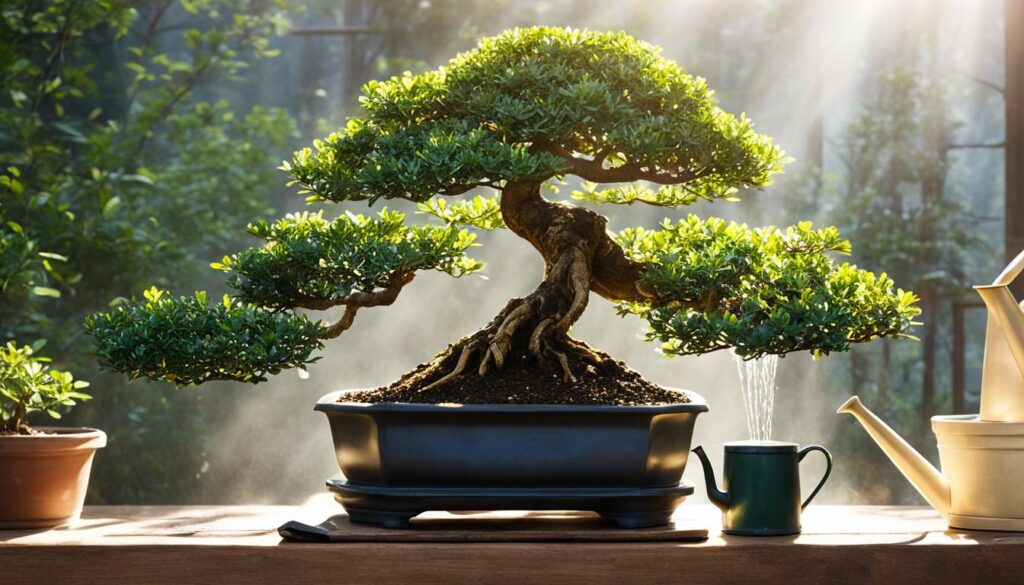
Maintaining the long-term health and vigor of your Boxwood Bonsai requires ongoing care and attention. By following a few essential maintenance tasks, you can ensure the longevity and vitality of your bonsai tree.
Regular watering: Boxwood Bonsai thrives in moist but well-draining soil. It’s crucial to water your bonsai tree consistently to keep the root system hydrated. Check the soil moisture regularly and water accordingly, avoiding both underwatering and overwatering.
Fertilizing: Providing adequate nutrition is essential for the health of your Boxwood Bonsai. Use a balanced bonsai fertilizer formulated specifically for boxwood bonsai to ensure proper growth and foliage development. Follow the manufacturer’s instructions for application rates and frequency.
Pest control: Keeping pests at bay is crucial to safeguarding the health of your Boxwood Bonsai. Regularly inspect your bonsai tree for common pests such as aphids, spider mites, and scale insects. If you spot any signs of infestation, take immediate action using appropriate organic or chemical pest control methods.
Seasonal care: Boxwood Bonsai has different care requirements throughout the year. During the growing season, typically spring and summer, your bonsai may require more frequent watering and fertilizing. In contrast, during the dormant season, usually fall and winter, reduce watering and suspend fertilization to allow the tree to rest.
Common troubleshooting techniques: Despite your best efforts, your Boxwood Bonsai may encounter some challenges. Monitor your bonsai tree closely for any signs of stress or disease, such as yellowing leaves or fungal growth. Address issues promptly by adjusting watering, providing appropriate treatment, or consulting a bonsai expert if needed.
By prioritizing the long-term health and vigor of your Boxwood Bonsai through consistent care and attention, you can enjoy the beauty and serenity of this miniature tree for years to come.
Propagating Boxwood Bonsai: Multiplying Your Miniature Trees
Are you fascinated by the beauty of Boxwood Bonsai and want to expand your collection? Propagating these miniature trees is an excellent way to multiply your Boxwood Bonsai while sharing their elegance with others. In this section, we will explore different methods of propagation to help you successfully grow new Boxwood Bonsai trees.
One method of propagating Boxwood Bonsai is through seed propagation. Collect mature seeds from the tree and sow them in a well-draining soil mixture. Keep the soil moist and place the container in a warm and bright location, such as a greenhouse or sunny windowsill. With patience and care, the seeds will germinate, and you can nurture the young seedlings into thriving bonsai trees.
Another popular propagation technique for Boxwood Bonsai is cutting propagation. Select healthy branches from the parent tree and make clean cuts just below a node. Remove any foliage from the lower portion of the cutting and dip the cut end in a rooting hormone. Plant the cutting in a well-draining soil mixture and provide it with sufficient moisture and indirect light. Over time, the cutting will develop roots and grow into a new Boxwood Bonsai.
Air layering is a more advanced method of propagation that involves creating a new root system on a branch while it is still connected to the parent tree. Make a small incision on the branch and apply rooting hormone to the exposed area. Wrap the incised portion with moist sphagnum moss, cover it with plastic wrap, and secure it in place. Keep the moss consistently moist and monitor the development of roots. Once a substantial root system has formed, detach the newly rooted section from the parent tree and pot it in a suitable bonsai pot.

